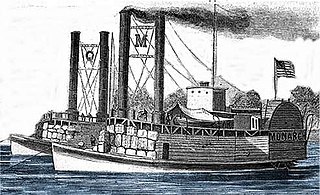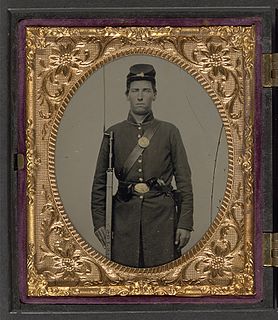| Expedition to Hernando | |||||||
|---|---|---|---|---|---|---|---|
| Part of the American Civil War | |||||||
| |||||||
| Belligerents | |||||||
| | |||||||
Expedition to Hernando was a military movement of the Union Army during the American Civil War.
Contents

| Expedition to Hernando | |||||||
|---|---|---|---|---|---|---|---|
| Part of the American Civil War | |||||||
| |||||||
| Belligerents | |||||||
| | |||||||
Expedition to Hernando was a military movement of the Union Army during the American Civil War.

On August 16, 1863, the Union force set out on an expedition to Hernando Mississippi from Memphis Tennessee, With a skirmish with Confederate combatants near Panola Mississippi on August 17, 1863. The Union force had returned to Memphis Tennessee on August 20, 1863, to end the expedition. [1]
A minor skirmish

USS Monarch was a United States Army sidewheel ram that saw service in the American Civil War as part of the United States Ram Fleet and the Mississippi Marine Brigade. She operated on the Mississippi River and Yazoo River during 1862 and 1863.
The 1st Kansas Infantry Regiment was an infantry regiment that served in the Union Army during the American Civil War. On August 10, 1861, at the Battle of Wilson's Creek, Missouri, the regiment suffered 106 soldiers killed in action or mortally wounded, one of the highest numbers of fatalities suffered by any Union infantry regiment in a single engagement during the American Civil War.
The 7th Kansas Cavalry Regiment was a cavalry regiment that served in the Union Army during the American Civil War.
The 7th Tennessee Cavalry Regiment was a cavalry regiment that served in the Union Army during the American Civil War. The regiment was also known as the 2nd West Tennessee Cavalry.
The 6th Tennessee Cavalry Regiment was a cavalry regiment that served in the Union Army during the American Civil War. The regiment was also known as the 1st West Tennessee Cavalry; and was sometimes referred to as Hurst's Worst by their opponents.
15th Ohio Battery was an artillery battery that served in the Union Army during the American Civil War.

The 118th Illinois Volunteer Infantry was an infantry regiment in the Union Army during the American Civil War. On June 10, 1863, the regiment was converted to mounted infantry.

The 113th Regiment Illinois Volunteer Infantry was an infantry regiment in the Union Army during the American Civil War.
The 16th Regiment Indiana Infantry was an infantry regiment in the Union Army during the American Civil War. In August 1863, the regiment was converted to mounted infantry for the remainder of the war.
3rd Indiana Battery Light Artillery was an artillery battery that served in the Union Army during the American Civil War.
6th Indiana Battery Light Artillery was an artillery battery that served in the Union Army during the American Civil War.
14th Indiana Battery Light Artillery was an artillery battery that served in the Union Army during the American Civil War.
The 11th/17th Consolidated Arkansas Infantry (1861–1865) was a Confederate Army infantry regiment during the American Civil War. The unit is also known as the 11th/17th Arkansas Mounted Infantry or the 11th/17th Arkansas Cavalry. At various times after the consolidation, members of the unit who were captured gave their unit as either the 11th Arkansas Cavalry or the 17th Arkansas Cavalry.
The 11th Missouri Infantry Regiment was an infantry regiment that served in the Union Army during the American Civil War.
89th Indiana Infantry Regiment was an infantry regiment that served in the Union Army in the Western Theater of the American Civil War.
Expedition after Forrest was a military movement of the Union Army during the American Civil War.
The 7th Regiment Indiana Cavalry was a cavalry regiment that served in the Union Army during the American Civil War.

The 1st Missouri Volunteer Cavalry Regiment was a cavalry regiment with three battalions that served in the Union Army during the American Civil War from 1861 to 1865.
The 2nd New Jersey Cavalry Regiment was a cavalry regiment that served in the Union Army during the American Civil War.
The 61st United States Colored Infantry was an infantry regiment that served in the Union Army during the American Civil War. The regiment was composed of African American enlisted men commanded by white officers and was authorized by the Bureau of Colored Troops which was created by the United States War Department on May 22, 1863. The non-commissioned officers and enlisted men were African Americans. The regiment was originally organized as the 2nd Tennessee Volunteer Infantry and was also referred to as the 2nd West Tennessee Infantry Regiment .